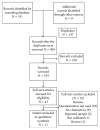Clinimetrics of the 9- and 19-Item Wearing-Off Questionnaire: A Systematic Review
- PMID: 29808113
- PMCID: PMC5902048
- DOI: 10.1155/2018/5308491
Clinimetrics of the 9- and 19-Item Wearing-Off Questionnaire: A Systematic Review
Abstract
The treatment of Parkinson's disease (PD) with dopaminergic therapy improves functionality and quality of life. However, as the disease progresses, the wearing-off phenomenon develops, which necessitates complex posology adjustment or adjuvant therapy. This phenomenon may not be well recognized, especially if it is mild or involves nonmotor symptoms. Questionnaires were developed to improve the recognition of the wearing-off phenomenon. The questionnaires consist of a list of symptoms that patients must check if they have and if the symptoms improve with medication. A recent review by the Movement Disorder Society suggested the 19-item (WOQ-19) and 9-item (WOQ-9) questionnaires as screening tools for the wearing-off phenomenon. However, there has not been a systematic review to assess the questionnaires' clinimetric properties, such as sensitivity, specificity, test-retest reliability, and responsiveness. We conducted an extensive search for studies using these two tools. We identified 3 studies using WOQ-19 and 5 studies using WOQ-9. Both questionnaires seem to have good sensitivity (0.81-1). WOQ-19 has variable specificity (0.39-0.8), depending on the number of positive items, while WOQ-9 lacks specificity (0.1-0.69). Only one study using WOQ-19 reported test-retest, and only two studies reported responsiveness. Thus, this report describes the first independent systematic review to exam quantitatively the clinimetric properties of these two questionnaires.
References
Publication types
LinkOut - more resources
Full Text Sources
Other Literature Sources


